The IMF Staff Climate Note Series
The IMF Notes Series aims to quickly disseminate succinct IMF analysis on critical economic issues to member countries and the broader policy community. The IMF Staff Climate Notes provide analysis related to the impact of climate change on macroeconomic and financial stability, including on mitigation, adaptation, and transition. The views expressed in IMF Staff Climate Notes are those of the author(s), although they do not necessarily represent the views of the IMF, or its Executive Board, or its management.- Sleepwalking to a Cliff Edge: A Wake-Up Call for Global Climate
- Harnessing Renewables in Sub-Saharan Africa: Barriers, Reforms, And Economic Prospects
- Policies to Foster Green FDI: Best Practices for Emerging Market and Developing Economies
- Destination Net Zero: The Urgent Need for a Global Carbon Tax on Aviation and Shipping
- Embedded In Nature: Nature-Related Economic and Financial Risks and Policy Considerations
- Key Challenges Faced by Fossil Fuel Exporters during the Energy Transition
- Energy Transition and Geoeconomic Fragmentation: Implications for Climate Scenario Design
- Is the Paris Agreement Working? A Stocktake of Global Climate Mitigation
- Climate Challenges in Fragile and Conflict-Affected States
- Getting on Track to Net Zero: Accelerating a Global Just Transition in This Decade
- Climate Change and Select Financial Instruments: An Overview of Opportunities and Challenges for Sub-Saharan Africa
- How to Cut Methane Emissions
- Mobilizing Private Climate Financing in Emerging Market and Developing Economies
- Carbon Taxes or Emissions Trading Systems? Instrument Choice and Design
- Approaches to Climate Risk Analysis in FSAPs
- Sovereign Climate Debt Instruments: An Overview of the Green and Catastrophe Bond Markets
- Climate Change Adaptation Series
- Not Yet on Track to Net Zero: The Urgent Need for Greater Ambition and Policy Action to Achieve Paris Temperature Goals
- Carbon Pricing: What Role for Border Carbon Adjustments?
- Strengthening the Climate Information Architecture
- Climate-Sensitive Management of Public Finances—"Green PFM”
- Proposal for an International Carbon Price Floor Among Large Emitters
Sleepwalking to a Cliff Edge: A Wake-Up Call for Global Climate

Urgent action to cut greenhouse gas (GHG) emissions is needed now. Early next year, all countries will set new emissions targets for 2035 while revising their 2030 targets. Global GHGs must be cut by 25 and 50 percent below 2019 levels by 2030 to limit global warming to 2°C and 1.5°C respectively. But current targets would only cut emissions by 12 percent, meaning global ambition needs to be doubled to quadrupled. Further delay will lead to an ‘emissions cliff edge’, implying implausible cuts in GHGs and putting put 1.5°C beyond reach. This Note provides IMF staff’s annual assessment of global climate mitigation policy. It illustrates options for equitably aligning country targets with the Paris Agreement’s temperature goals. It also provides guidance on modelling needed to set emissions targets and quantify climate mitigation policy impacts.
Harnessing Renewables in Sub-Saharan Africa: Barriers, Reforms, And Economic Prospects
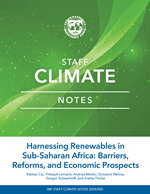
Sub-Saharan Africa needs to significantly accelerate its electricity generation. While hydropower is prominent in some countries, solar and wind power generation has lagged other world regions, even though sub-Saharan Africa has some of the most favorable conditions. A mix of domestic and external financing can increase both renewable electricity generation and GDP. In a scenario where about $25 bn in climate finance flows are allocated annually to renewable energy, renewable electricity production could be up to 24 percent higher than in a scenario excluding this financing, and annual GDP growth would be boosted by 0.8 percentage point on average over the next decade, accompanied by stronger labor demand in the electricity sector. Policies can help catalyze climate finance. An ambitious package of governance, business regulations, and external sector reforms is associated with a 20 percent increase in climate finance flows and a 7 percent increase in electricity generation over five years. In addition, implementing climate policies is linked to increases in green foreign direct investment announcements and green electricity production.
Policies to Foster Green FDI: Best Practices for Emerging Market and Developing Economies
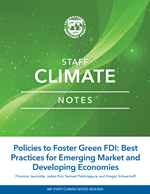
Meeting COP28 goals requires a substantial increase in clean energy investment by 2030, including in emerging market and developing economies (EMDEs). Amid domestic financial constraints, foreign direct investment (FDI) could play a key role in EMDEs’ ability to close their renewable energy investment gap and finance green projects, more broadly. This Note finds that strengthening climate policies boosts FDI into renewable energy in EMDEs, especially in those with solar power potential, while less clear effects are found for FDI into EVs and green hydrogen possibly due to their recent emergence. Closing the average climate policy gap with respect to AEs could secure 40 percent of the private finance needed for renewable energy investment in EMDEs, helping overcome the impact of high financing costs. Strengthening the macro-structural framework, such as through improving trade and capital account openness and institutional quality, would also raise green FDI inflows, complementing climate policies. Case studies show that countries that attracted FDI into renewable energy put in place a large and diverse set of policies in the electricity sector, including those that secure a revenue stream for investors in the initial phases, such as power-purchase agreements/feed-in tariffs, renewables targets, and complementary investments. Countries that successfully attracted FDI into EVs relied on the development of national sectoral strategies including production and adoption subsidies, prior comparative advantage in the sector, and bilateral alliances with key players in the EV market. Finally, comprehensive national hydrogen strategies that leverage international efforts to boost production, and good conditions for production of renewable energy, were key drivers of green hydrogen FDI. Global initiatives such as the Just Energy Transition Partnerships and the EU strategy for green hydrogen are benefitting FDI to EMDEs.
Destination Net Zero: The Urgent Need for a Global Carbon Tax on Aviation and Shipping
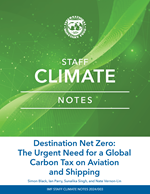
The need to decarbonize international aviation and maritime has long been overlooked. The two sectors account for a small but rapidly growing share of global CO2 emissions, and could rise to as much as 15 to 40 percent by 2040. Pricing these emissions could help global climate policy in two ways. First, it could accelerate technological development while incentivizing efficiency, kick-starting the sectors’ transition to net zero while addressing the sectors’ hitherto favorable tax treatment. Second, pricing could raise up to $200 billion a year in revenues by 2035, which could be allocated to climate finance or other uses. There are significant political obstacles, however, notably reaching consensus on revenue allocation and managing price impacts, which are substantive for flight tickets but less so for shipped goods. Pricing variants, like ‘fee and rebate’ schemes (feebates), have lower price impacts but raise fewer revenues. This paper discusses these policies, using a new model to quantify impacts on fuel use, emissions, revenues, production and economic costs, and on vulnerable states.
Embedded In Nature: Nature-Related Economic and Financial Risks and Policy Considerations

The economy is embedded in, and dependent on, nature. Yet economic activity is degrading nature at an unprecedented pace. Interacting with climate change, nature loss and transformation generates significant threats to the global economy and financial system. However, work on the implications of nature-related risks for macroeconomic and financial sector policies remains at an early stage. This note seeks to contribute to this emerging policy space in three main ways: (i) it proposes a conceptual framework for understanding nature-related risks by mapping out macroeconomic transmission channels, emphasizing their impact on the economy and financial systems through “double materiality;” (ii) it conducts empirical analysis, finding that nearly 38 percent of bank loans of the 100 largest global banks are to harmful subsidies-dependent sectors and 44 percent are exposed to conservation areas under the Global Biodiversity Framework, and that industries most exposed to nature degradation are not well prepared to manage these risks; and (iii) it discusses takeaways for macroeconomic and financial sector policies and frameworks.
Key Challenges Faced by Fossil Fuel Exporters during the Energy Transition
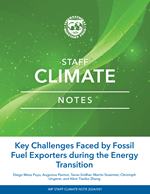
The global energy transition is affecting fossil fuel exporters from multiple angles. It is adding to longstanding uncertainties on relative movements of fossil fuel demand and supply—which impact fossil fuel-related exports, fiscal flows, investment and subsequently external and fiscal accounts, economic growth, and employment. While policymakers are very familiar with these challenges, they now also face expectations of a permanent decline in the long-run global demand for fossil fuels. Key factors that could determine country-level impacts include (i) the type of fossil fuel a country exports (ii) extraction costs and (iii) country characteristics. The monitoring and mitigation of fiscal risks will need to be stepped up. Fiscal policy also has a role in reducing domestic emissions, encouraging adoption of low-carbon technologies, and helping those most vulnerable to changes from the transition. Broader macroeconomic risks can be reduced by accelerating ongoing structural reforms that support alternative engines of growth. Low- or zero-carbon emission energy industries could offer new avenues that build on existing fossil fuel knowledge and infrastructure. Concurrently, improved financial regulation and supervision could reduce financial sector exposures. Finally, international coordination on the design and implementation of climate policy as well as international transfer schemes (financing and capacity development) could reduce uncertainties surrounding the transition path and associated adverse economic consequences.
Energy Transition and Geoeconomic Fragmentation: Implications for Climate Scenario Design
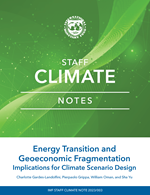
The transition to a low-carbon economy, which is needed to mitigate climate change and meet the Paris Agreement temperature goals, has been affected by the supply chain and energy supply disruptions that originated during the COVID-19 pandemic, the Russian invasion of Ukraine, and the subsequent energy crisis and exacerbation of geopolitical tensions. These developments, and the broader context of the ongoing “polycrisis,” can affect future decarbonization scenarios. This reflects three main factors: (1) pullbacks in climate mitigation policies and increased carbon lock-in in fossil fuel infrastructure and policymaking; (2) the decreasing likelihood of continuous cost reduction in renewable energy technologies; and (3) the likely intensification of macroeconomic shocks amid increasing geoeconomic fragmentation, and the associated policy responses. In this context, the note assesses the implications of the polycrisis for hypothetical scenarios used to assess climate-related financial risks. Following an analysis of the channels through which these effects are likely to materialize over short- and long-term horizons and some policy implications, the note proposes potential adjustments to the design of the climate scenarios used by financial institutions, central banks, and financial sector supervisors and regulators within their risk management frameworks.
Is the Paris Agreement Working? A Stocktake of Global Climate Mitigation
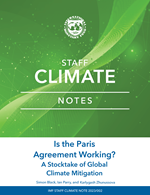
Urgent and aggressive action to cut greenhouse gas emissions this decade is needed. As countries take stock of the Paris Agreement, this Note provides IMF staff’s annual assessment of global climate mitigation policy. Global ambition needs to be more than quadrupled: emissions cuts of 50 percent below 2019 levels by 2030 are needed for 1.5 degrees Celsius, but current targets would only achieve 11 percent. We provide options for ratcheting-up ambition equitably. Implementation could be accelerated via agreements on minimum carbon prices. Drastic increases in mitigation investment are needed, requiring policies to shift private sector incentives. Climate finance should be scaled-up, with a new goal aligned with needs in developing countries. The development and diffusion of low-carbon technologies should be accelerated collaboratively. Overall, the Paris Agreement is making progress, but a response to the Global Stocktake that prioritizes decisive action this decade is critical.
Climate Challenges in Fragile and Conflict-Affected States
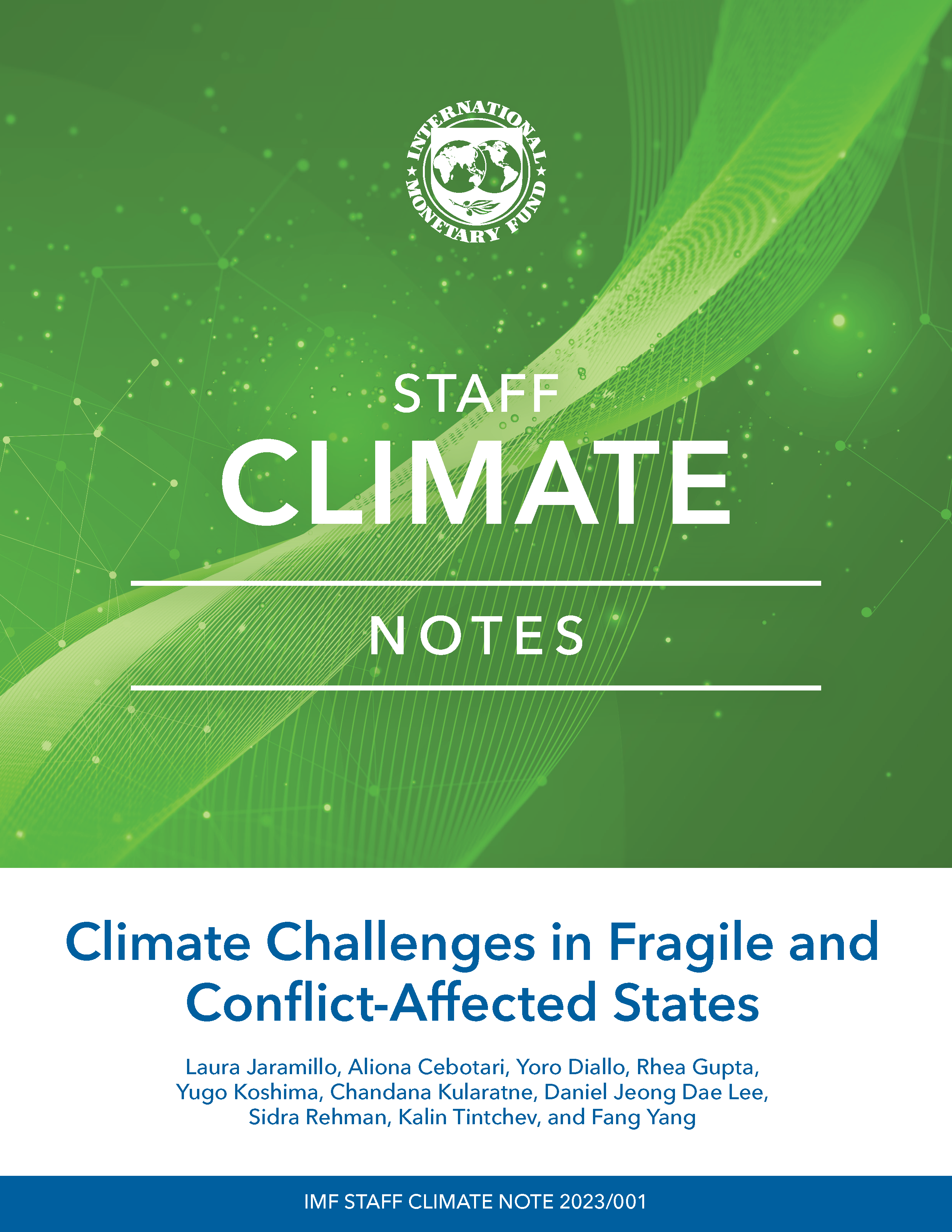
Fragile and conflict-affected states (FCS) already face higher temperatures than other countries and will be more exposed to extreme heat and weather events going forward. Using innovative approaches, the paper finds that in FCS, climate vulnerability and underlying fragilities—namely conflict, heavy dependence on rainfed agriculture, and weak capacity—exacerbate each other, amplifying the negative impact on people and economies. FCS suffer more severe and persistent GDP losses than other countries due to climate shocks because their underlying fragilities amplify the impact of shocks, in particular in agriculture. At the same time, climate shocks worsen underlying fragilities, namely conflict. Macro-critical adaptation policies are needed to facilitate the immediate response to climate shocks and to build climate resilience over time. Sizeable and sustained international support—especially grants, concessional financing and capacity development—is urgent to avoid worse outcomes, including forced displacement and migration. The IMF is stepping up support to FCS in dealing with climate challenges through carefully tailored policy advice, financing, and capacity development.
Getting on Track to Net Zero: Accelerating a Global Just Transition in This Decade
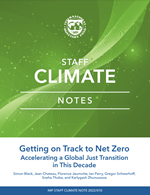
To contain global warming to between 2°C and 1.5°C, global greenhouse gas emissions must be cut 25 to 50 percent below 2019 levels by 2030. Even if fully achieved, current country pledges would cut global emissions by just 11 percent. This Note presents illustrative options for closing this ambition gap equitably and discusses their economic impacts across countries. Options exist to accelerate a global just transition in this decade, involving greater emission reductions by high-income countries and climate finance, but further delays in climate action would put 1.5°C beyond reach. Global abatement costs remain low under 2°C-consistent scenarios, with burdens rising with income levels. With efficient policies of carbon pricing with productive revenue use, welfare costs become negative when including domestic environmental co-benefits, before even counting climate benefits. GDP effects from global decarbonization remain uncertain, but modeling suggests they exceed abatement costs especially for carbon-intensive and fossil-fuel-exporting countries. Ratcheting up climate finance can help make global decarbonization efforts more progressive.
Climate Change and Select Financial Instruments: An Overview of Opportunities and Challenges for Sub-Saharan Africa
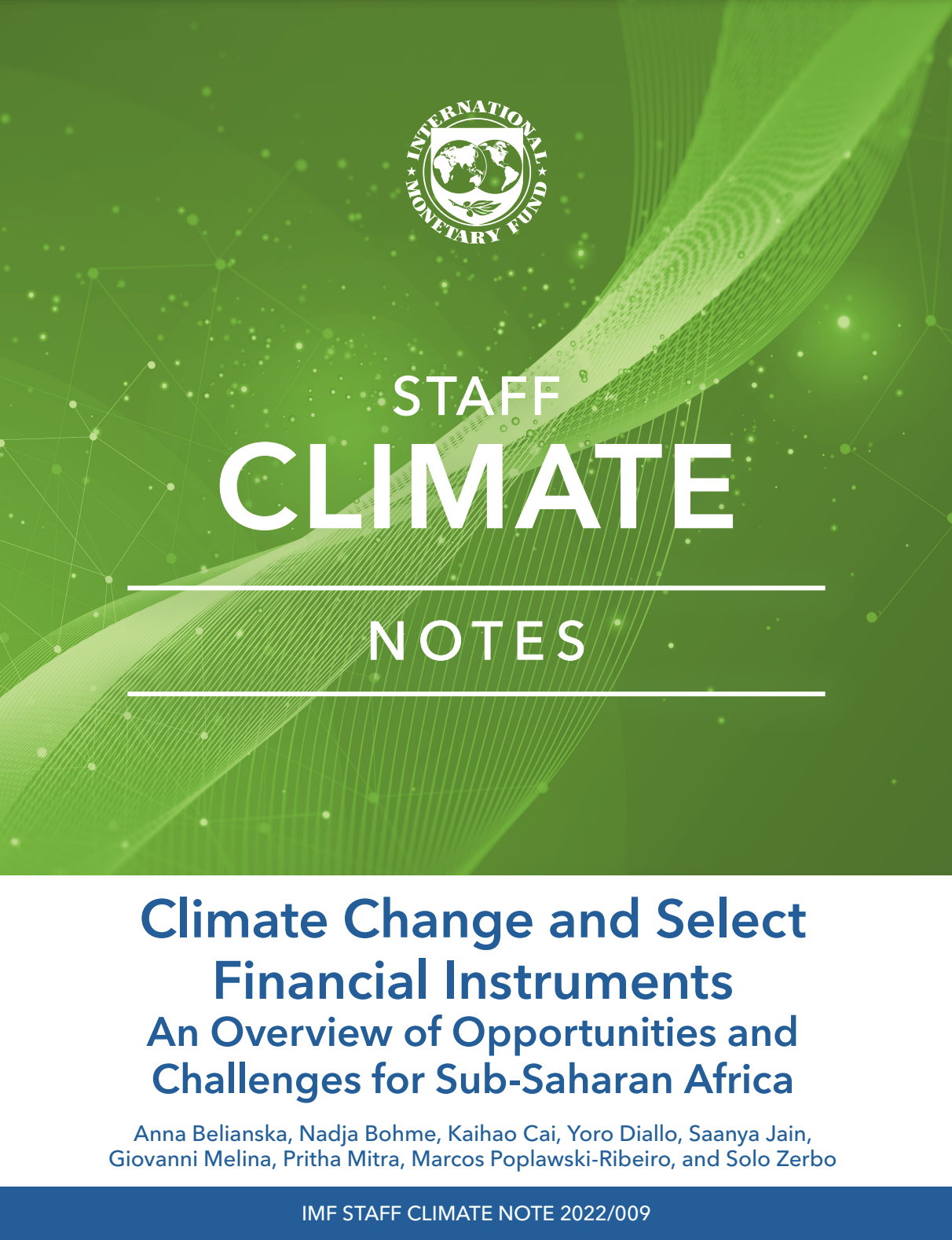
Sub-Saharan Africa (SSA) is the region in the world most vulnerable to climate change despite its cumulatively emitting the least amount of greenhouse gases. Substantial financing is urgently needed across the economy—for governments, businesses, and households—to support climate change adaptation and mitigation, which are critical for advancing resilient and green economic development as well as meeting commitments under the Paris Agreement. Given the immensity of SSA’s other development needs, this financing must be in addition to existing commitments on development finance. There are many potential ways to raise financing to meet adaptation and mitigation needs, spanning from domestic revenue mobilization to various forms of international private financing. Against this backdrop, SSA policymakers and stakeholders are exploring sources of financing for climate action that countries may not have used substantially in the past. This Staff Climate Note presents some basic information on opportunities and challenges associated with these financing instruments.
How to Cut Methane Emissions
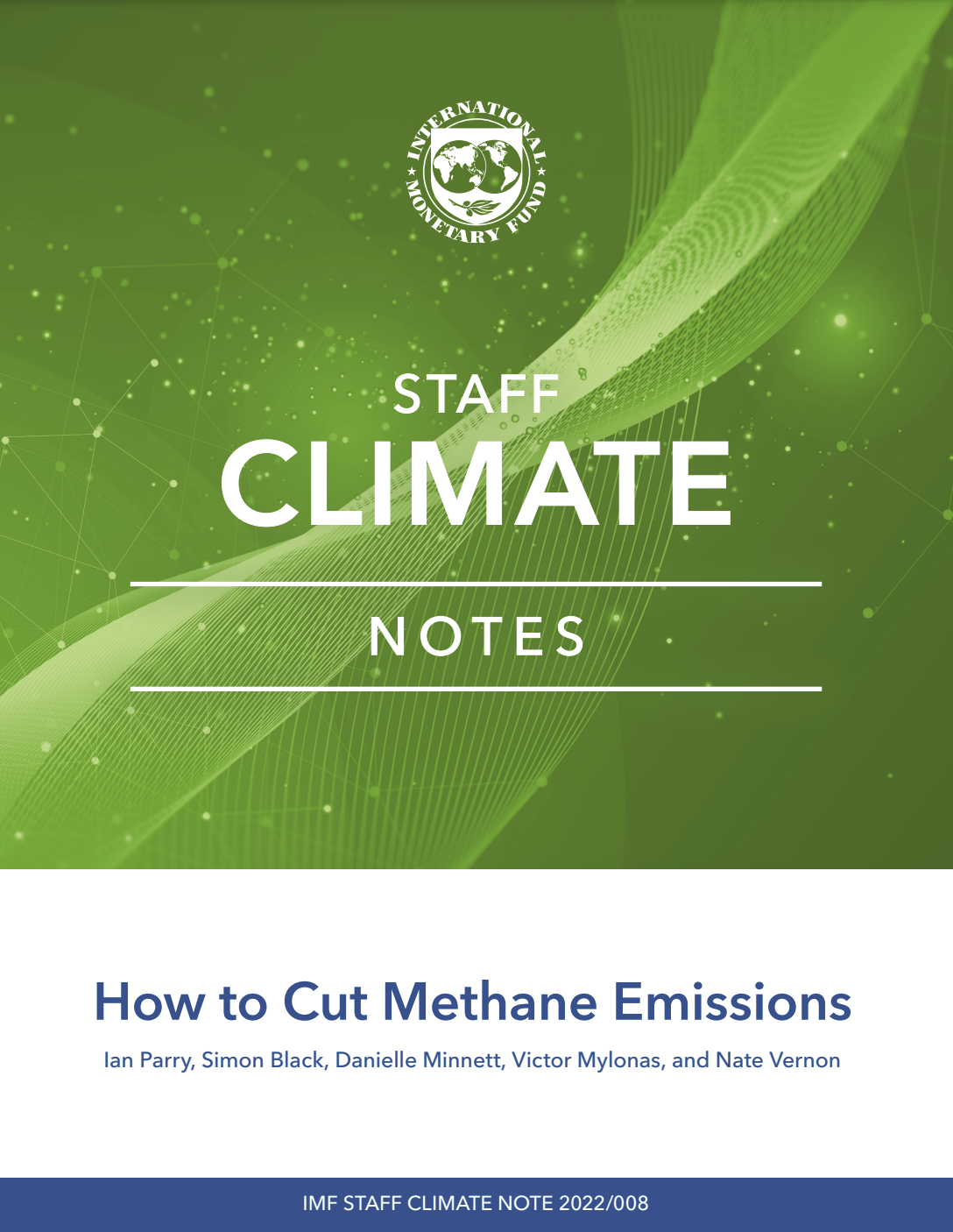
Limiting global warming to 1.5 to 2°C above preindustrial levels requires rapid cuts in greenhouse gas emissions. This includes methane, which has an outsized impact on temperatures. To date, 125 countries have pledged to cut global methane emissions by 30 percent by 2030. This Note provides background on methane emission sources, presents practical fiscal policy options to cut emissions, and assesses impacts. Putting a price on methane, ideally through a fee, would reduce emissions efficiently, and can be administratively straightforward for extractives industries and, in some cases, agriculture. Policies could also include revenue-neutral ‘feebates’ that use fees on dirtier polluters to subsidize cleaner producers. A $70 methane fee among large economies would align 2030 emissions with 2oC. Most cuts would be in extractives and abatement costs would be equivalent to just 0.1 percent of GDP. Costs are larger in certain developing countries, implying climate finance could be a key element of a global agreement on a minimum methane price.
Mobilizing Private Climate Financing in Emerging Market and Developing Economies
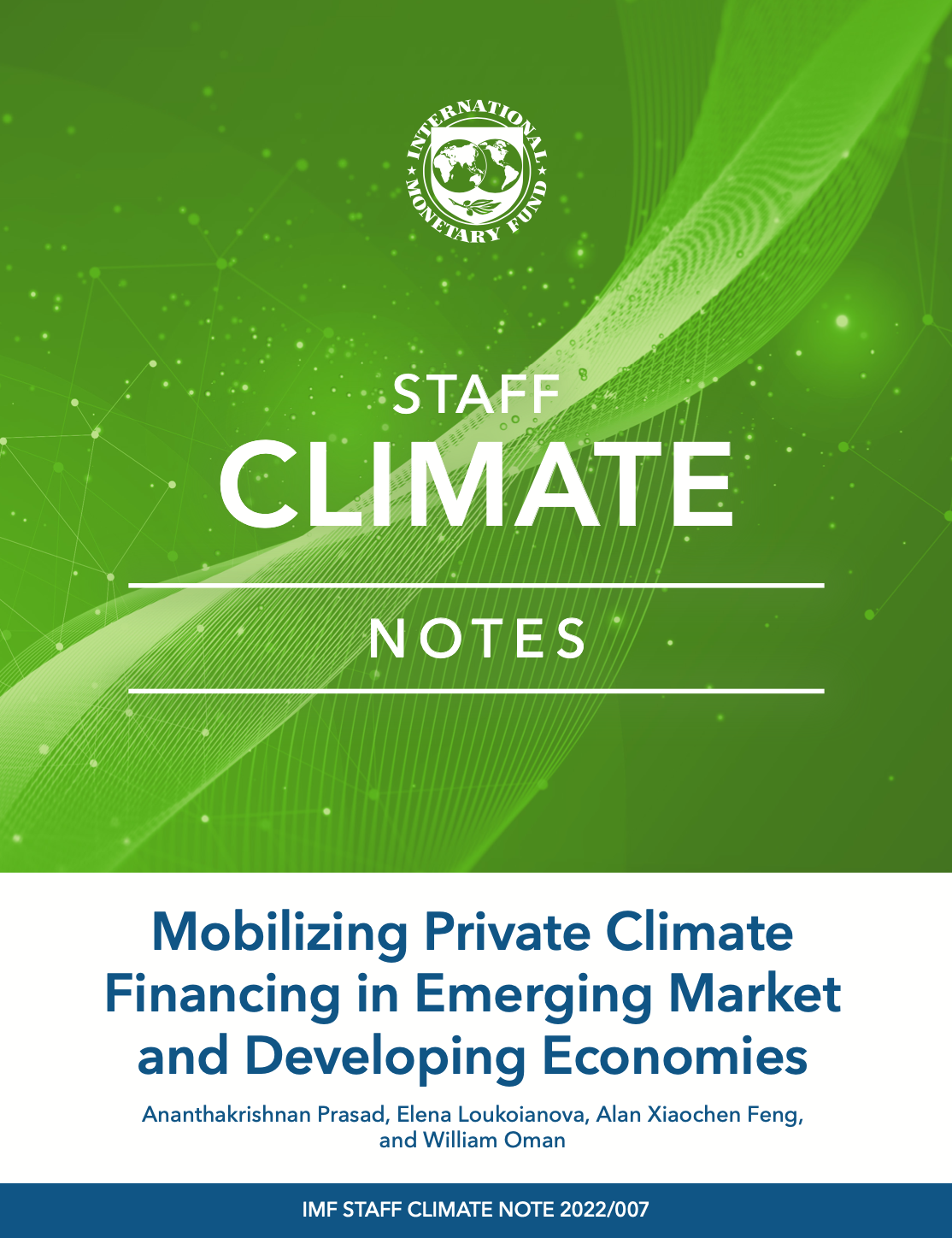
Global investment to achieve the Paris Agreement’s temperature and adaptation goals requires immediate actions—first and foremost—on climate policies. Policies should be accompanied by commensurate financing flows to close the large financing gap globally, and in emerging market and developing economies (EMDEs) in particular. This note discusses potential ways to mobilize domestic and foreign private sector capital in climate finance, as a complement to climate-related policies, by mitigating relevant risks and constraints through public-private partnerships involving multilateral, regional, and national development banks. It also overviews the role the IMF can play in the process.
Carbon Taxes or Emissions Trading Systems? Instrument Choice and Design
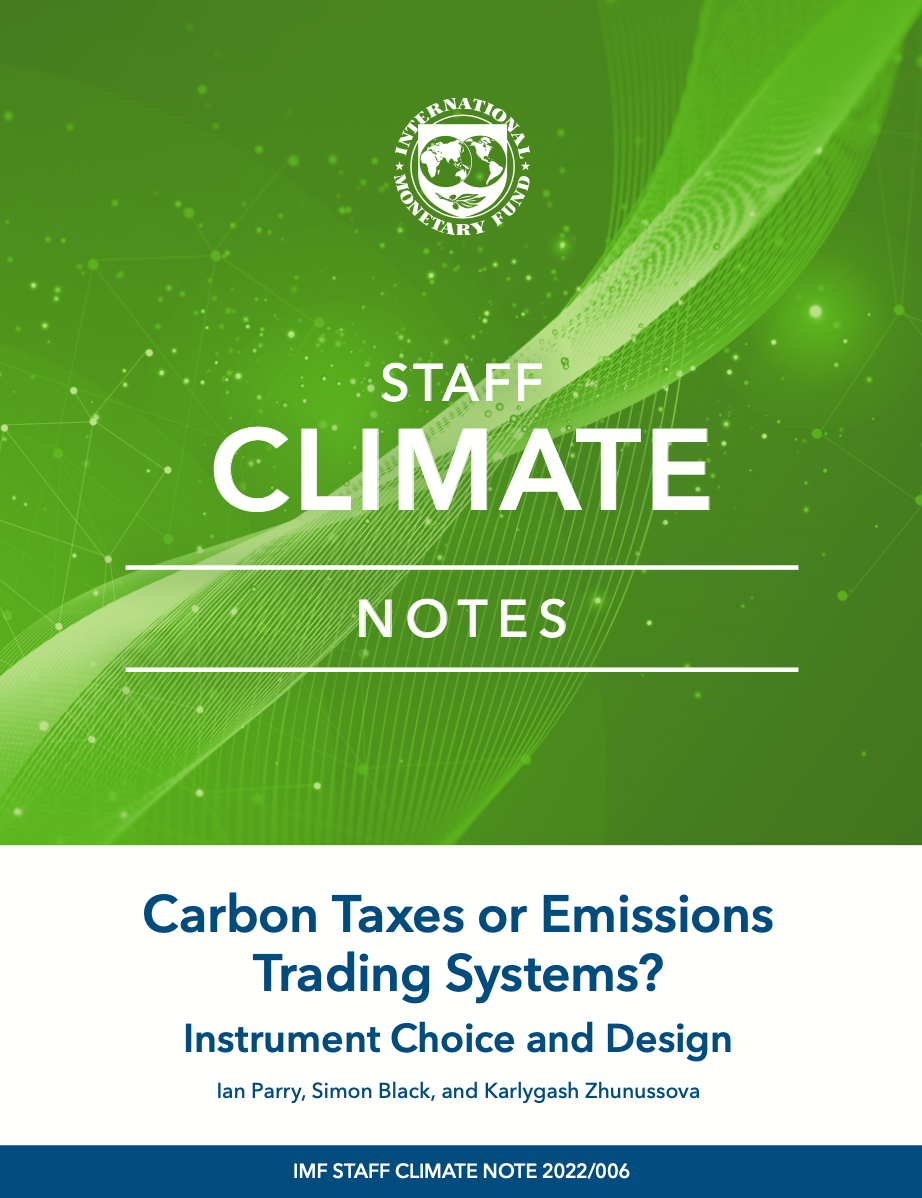
Carbon pricing should be a central element of climate mitigation strategies, helping countries rapidly transition to “net zero” greenhouse gas emissions. Policymakers considering carbon pricing face choices between carbon taxes and emissions trading systems (ETSs) and in their design. This includes administration, price levels, emissions coverage, relation to other mitigation instruments, use of revenues to address efficiency and distributional objectives, supporting measures to address competitiveness concerns, political economy aspects, and coordination at the global level. This paper discusses these issues, providing guidance on the choice between carbon taxes and ETSs and their design. Overall, carbon taxes have significant practical, environmental, and economic advantages (especially for developing countries) due to ease of administration, price certainty which promotes investment, the potential to raise significant revenues, and coverage of broader emissions sources. However, ETSs provide more certainty over emissions levels, can be implemented by environment ministries, and some free permit allocations might garner political support from affected firms (at a fiscal cost).
Approaches to Climate Risk Analysis in FSAPs
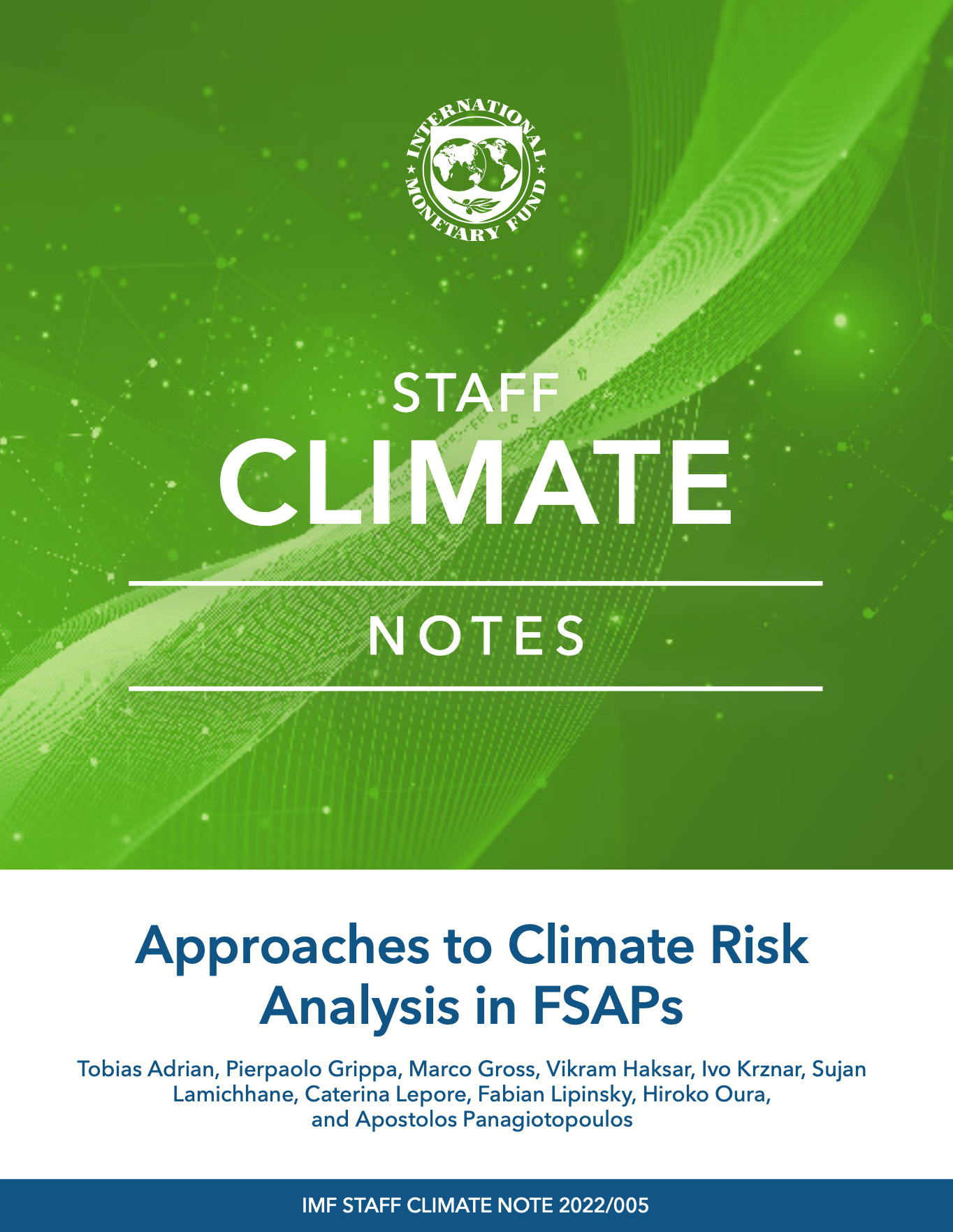
Climate change presents risks and opportunities for the real economies and financial sectors of the IMF’s global membership. Understanding the risks is key to prepare for a successful transition to a lower carbon global economy. This will unlock the many opportunities for technological progress and structural transformation along the path that financial sectors around the world will need to adapt to and support. This note lays out the IMF staff’s emerging approach to assessing the impact of climate change on banking sector stability risks conducted in the context of the IMF Financial Sector Assessment Program (FSAP). The note starts with a primer on climate change risk, both transition and physical, explaining some of the technical terms and concepts used in this work. It explains the approach to standard risk analysis in FSAPs and how this would be modified in broad terms to incorporate climate risk. The note then discusses different approaches to the analysis of physical versus transition risk, their implications for the macro-economy and across sectors in the real economy and different geographies, and how all these effects map into the banking sector. The note illustrates concepts with examples of applications from recent FSAPs and takes note of the many challenges confronting this work, including data gaps and uncertainty regarding climate projections and long simulation horizons in conducting the climate risk analysis. As such the note is focused on methods that IMF staff are deploying to raise awareness of the risks, and adaptation needs, including need for banks to develop tools to manage climate risks and for financial sector supervisory authorities to identify pressure points in the financial system adequately respond and supervise this risk.
Sovereign Climate Debt Instruments: An Overview of the Green and Catastrophe Bond Markets
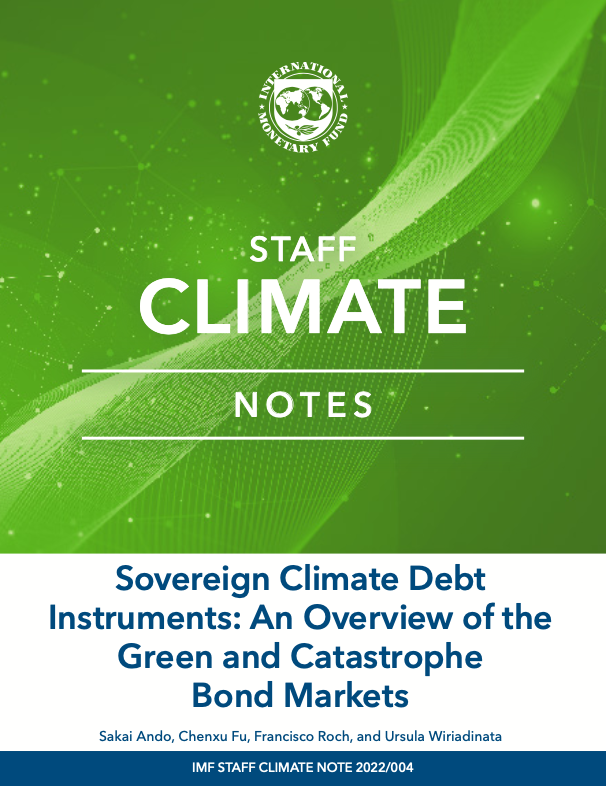
Financial markets will play a catalytic role in financing the adaptation and mitigation to climate change. Catastrophe and green bonds in the private sector have become the most prominent innovations in the field of sustainable finance in the last 15 years. Yet the issuances at the sovereign level have been relatively recent and not well documented in the literature. This note discusses the benefits of issuing these instruments as well as practical implementation challenges impairing the scaling up of these markets. The issuance of these instruments could provide a wider source of stable financing with more favorable market access conditions, mitigate the stress of climate risks on public finances, and facilitate the transition to greener low- carbon economies. Emerging market and developing economies stand to benefit the most from these financial innovations.
Climate Change Adaptation Series
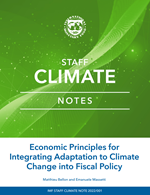
March 23, 2022
Adaptation to climate change is a necessity for advanced and developing economies alike. Policymakers face the challenge of facilitating this transition. This Note argues that adaptation to climate change should be part of a holistic development strategy involving both private and public sector responses. Governments can prioritize public investment in adaptation programs with positive externalities, address market imperfections and policies that make private adaptation inefficient, and mobilize revenues for, and distribute the benefits of, adaptation. Although the choice of what should be done and at what cost ultimately depends on each society’s preferences, economic theory provides a useful framework to maximize the impact of public spending. Cost-benefit analysis, complemented by the analysis of distributional effects, can be used to prioritize adaptation programs as well as all other development programs to promote an efficient and just transition to a changed climate. While compensations may be needed to offset damages that are either impossible or too expensive to abate, subsidies for adaptation require careful calibration to prevent excessive risk taking.
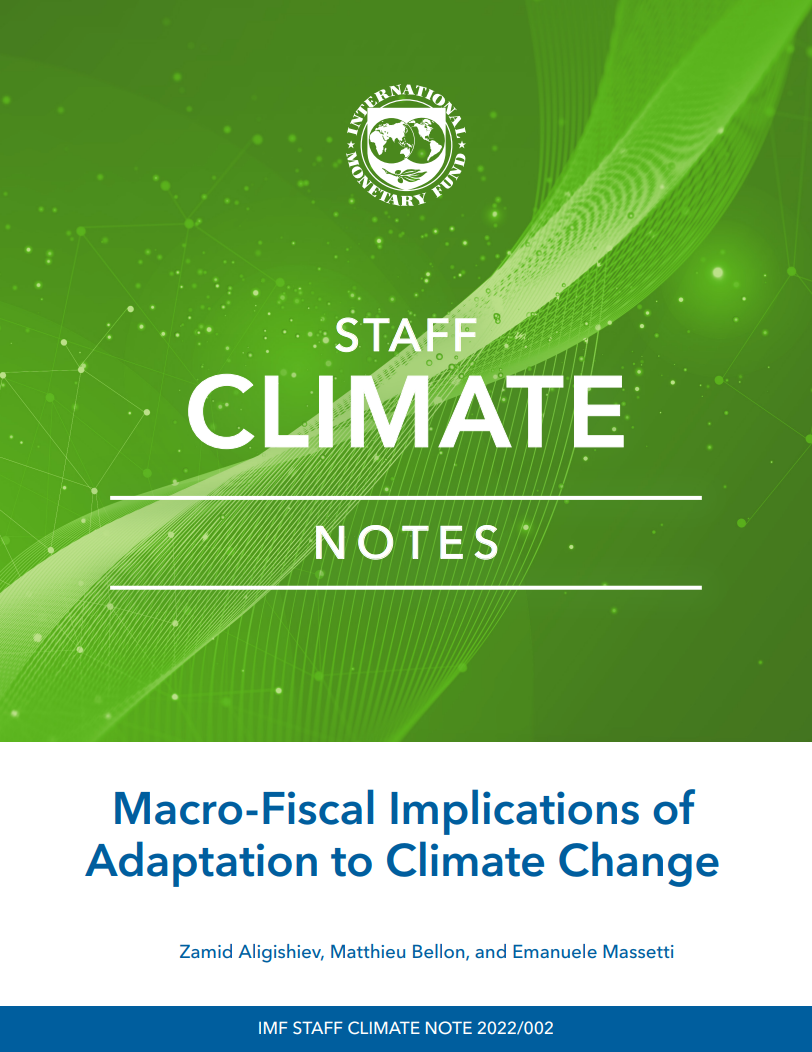
March 23, 2022
Adaptation reduces climate change damages but is costly and cannot eliminate all risks. Governments have to decide on an acceptable balance of residual risks and to determine adaptation investment needs by weighing costs, benefits, and distributional effects. A literature review suggests that well-designed and well-implemented adaptation can have large returns. Global public adaptation needs in 2030 are estimated in the literature at around ¼ percent of world GDP per year, but with very large disparities across countries and high uncertainty. Our analysis points to annual adaptation costs exceeding 1 percent of GDP for some developing countries, and above 10 percent of GDP for some island states. Many of these countries—despite typically not having contributed to global warming—face high adaptation needs while being challenged by limited fiscal space, limited capacity, or both, calling for additional support from the international community. To help guide national fiscal policies, countries could integrate climate risks and the cost of adaptation into their macro-fiscal frameworks. Shock scenarios are useful to reflect short-term impacts of climate disasters, while the long-term analysis of risks and uncertainties surrounding climate change requires scenarios that cover impacts from changes in both average and extreme events, as well as adaptation policies.
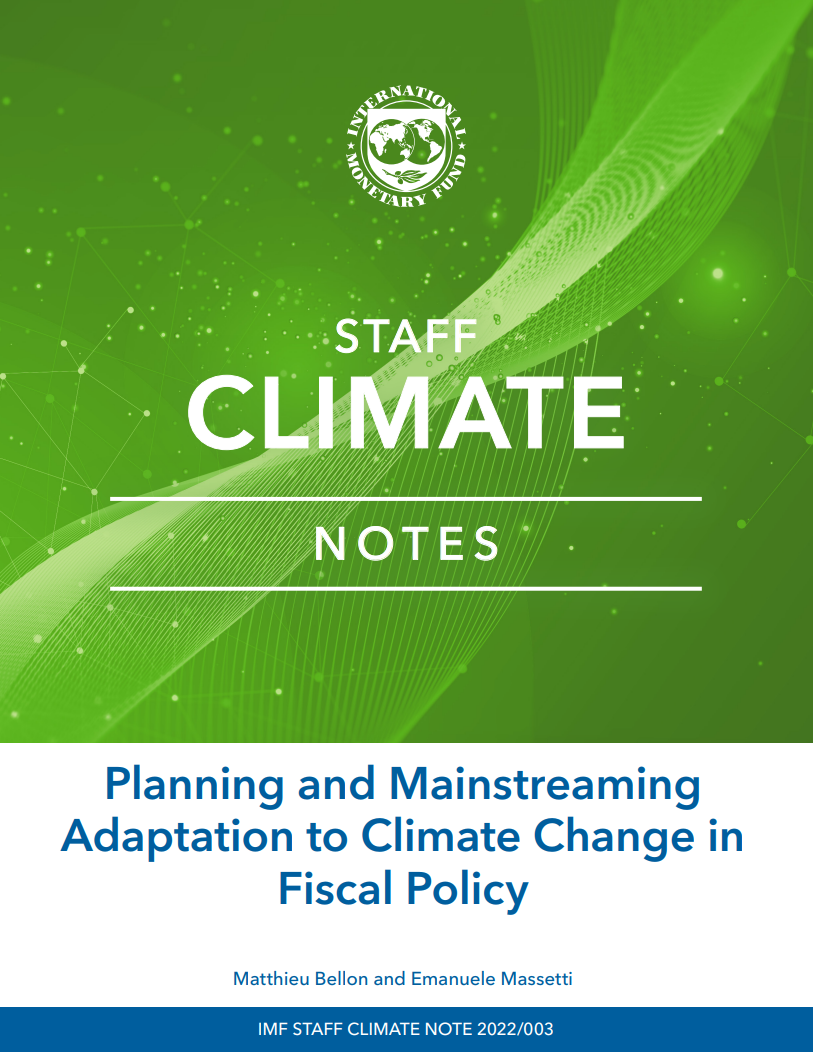
March 23, 2022
Adaptation to climate change is an integral part of sustainable development and a necessity for advanced and developing economies alike. How can adaptation be planned for and mainstreamed into fiscal policy? Setting up inclusive coordination mechanisms and strengthening legal foundations to incorporate climate change can be a prerequisite. This Note identifies four building blocks: 1- Taking stock of present and future climate risks, identifying knowledge and capacity gaps, and establishing guidance for next steps. 2- Developing adaptation solutions. This block can be guided by extending the IMF three-pillar disaster resilience strategy to address changes in both extreme and average weather and would cover the prevention of risks, the alleviation of residual risks, and macro-fiscal resilience. 3- Mainstreaming these solutions into government operations. This requires strengthening public financial management institutions by factoring climate risks and adaptation plans into budgets and macro-frameworks, and in the management of public investment, assets and liabilities. 4- Providing for transparent evaluations to inform future plans. This involves continually monitoring progress and regularly updating adaptation plans.
Not Yet on Track to Net Zero: The Urgent Need for Greater Ambition and Policy Action to Achieve Paris Temperature Goals
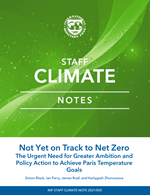
Achieving the Paris Agreement’s temperature goals requires cutting global CO2 emissions 25 to 50 percent this decade, followed by a rapid transition to net zero emissions. The world is currently not yet on track so there is an urgent need to narrow gaps in climate mitigation ambition and policy. Current mitigation pledges for 2030 would achieve just one to two thirds of the emissions reductions needed for limiting warming to 1.5 to 2 degrees Celsius. And additional measures equivalent to a global carbon price exceeding $75 per ton by 2030 are needed. This IMF Staff Climate Note presents extensive quantitative analyses to inform dialogue on closing mitigation ambition and policy gaps. It shows illustrative pathways to achieve the needed global emissions reductions while respecting international equity. The Note also presents country-level analyses of the emissions, fiscal, economic, and distributional impacts of carbon pricing and the trade-offs with other instruments—comprehensive mitigation strategies will be key.
Carbon Pricing: What Role for Border Carbon Adjustments?
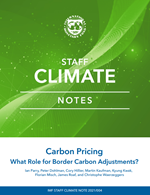
This Climate Note discusses the rationale, design, and impacts of border carbon adjustments (BCAs), charges on embodied carbon in imports potentially matched by rebates for embodied carbon in exports. Large disparities in carbon pricing between countries is raising concerns about competitiveness and emissions leakage, and BCAs are a potentially effective instrument for addressing such concerns. Design details are critical, however. For example, limiting coverage of the BCA to energy-intensive, trade-exposed industries facilitates administration, and initially benchmarking BCAs on domestic emissions intensities would help ease the transition for emissions-intensive trading partners. It is also important to consider how to apply BCAs across countries with different approaches to emissions mitigation. BCAs are challenging because they pose legal risks and may be at odds with the differentiated responsibilities of developing countries. Furthermore, BCAs provide only modest incentives for other large emitting countries to scale carbon pricing—an international carbon price floor would be far more effective in this regard.
Strengthening the Climate Information Architecture
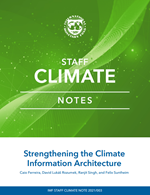
Strengthening the climate information architecture is paramount to promote transparency and global comparability of data and thus improve market confidence, safeguard financial stability, and foster sustainable finance. This note provides a conceptual framework around the provision of climate-related information, discusses the progress made to date, and points toward the way forward. Progress and convergence are required on the three buildings blocks of a climate information architecture: (1) high-quality, reliable, and comparable data; (2) a globally harmonized and consistent set of climate disclosure standards; and (3) a globally agreed upon set of principles for climate finance taxonomies. A decisive, globally coordinated effort is needed to move forward on all three fronts.
Climate-Sensitive Management of Public Finances—"Green PFM”
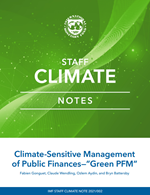
Public financial management (PFM) consists of all the government’s institutional arrangements in place to facilitate the implementation of fiscal policies. In response to the growing urgency to fight climate change, “green PFM” aims at adapting existing PFM practices to support climate-sensitive policies. With the cross-cutting nature of climate change and wider environmental concerns, green PFM can be a key enabler of an integrated government strategy to combat climate change. This note outlines a framework for green PFM, emphasizing the need for an approach combining various entry points within, across, and beyond the budget cycle. This includes components such as fiscal transparency and external oversight, and coordination with state-owned enterprises and subnational governments. The note also identifies principles for effective implementation of a green PFM strategy, among which the need for a strong stewardship located within the ministry of finance is paramount.
Proposal for an International Carbon Price Floor Among Large Emitters
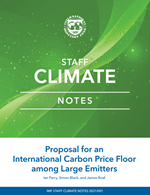
Countries are increasingly committing to midcentury ‘net-zero’ emissions targets under the Paris Agreement, but limiting global warming to 1.5 to 2°C requires cutting emissions by a quarter to a half in this decade. Making sufficient progress to stabilizing the climate therefore requires ratcheting up near-term mitigation action but doing so among 195 parties simultaneously is proving challenging. Reinforcing the Paris Agreement with an international carbon price floor (ICPF) could jump-start emissions reductions through substantive policy action, while circumventing emerging pressure for border carbon adjustments. The ICPF has two elements: (1) a small number of key large-emitting countries, and (2) the minimum carbon price each commits to implement. The arrangement can be pragmatically designed to accommodate equity considerations and emissions-equivalent alternatives to carbon pricing. The paper discusses the rationale for an ICPF, considers design issues, compares it with alternative global regimes, and quantifies its impacts.



